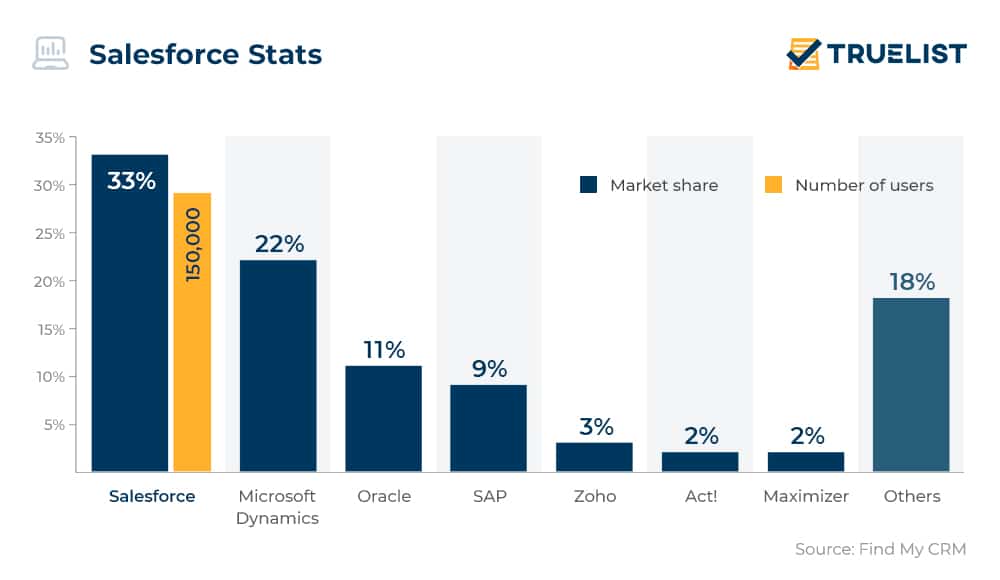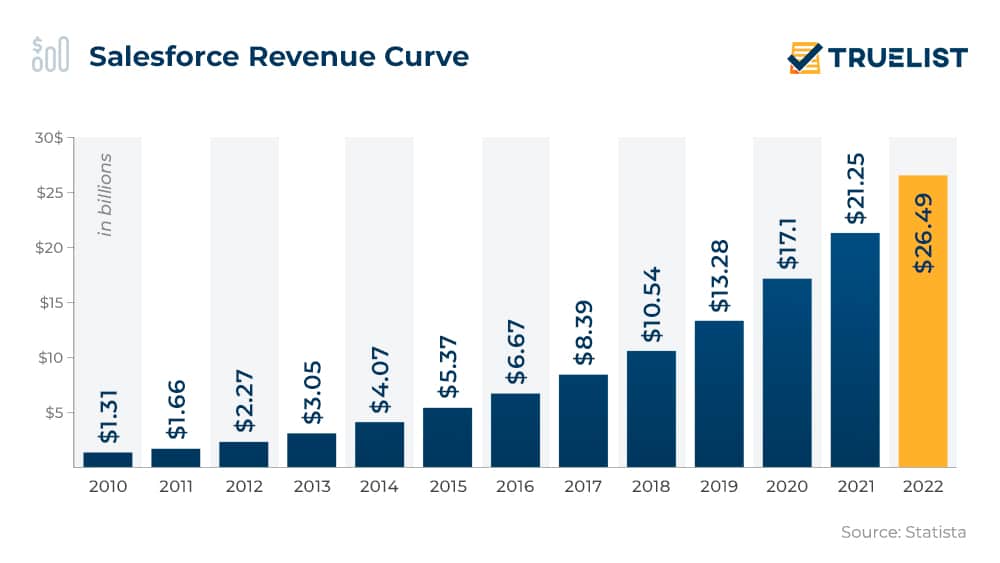Salesforce is one of the most popular CRMs on the market, and for a good reason. This, however, doesn’t mean that it comes without any risks or drawbacks. That’s why we’re going to explore some essential Salesforce statistics to help you get a better idea of whether or not your business needs to start using this solution and, if so, where you should focus your efforts when implementing it.
Salesforce Statistics (Еditor’s Choice)
- Salesforce bought Slack for $27.7 billion in 2021. (Salesforce)
- The Salesforce number of customers stands at 150,000. (Backlinko)
- CRM user adoption for sales professionals is 73%. (Nutshell)
- Salesforce has 33.6% female workers. (iTechArt)
- 62% of the companies using Salesforce are in the US. (Statista)
- 90% of Fortune 500 companies use Salesforce. (Join Colossus)
- Salesforce has 29,000 employees. (Salesforce)
- Salesforce’s revenue reached $26.49 billion in 2022. (Salesforce)
Salesforce Stats
1. The Salesforce market share accounts for a third of the whole CRM market.
The Salesforce number of users exceeds 150,000 businesses, placing the platform as the most widely used CRM system, with 33%. Microsoft’s Dynamics platform is the runner-up with 22%, while Oracle rounds up the top three with 11%.
(Backlinko, Statista, Find My CRM)

2. Salesforce revenue has grown by more than 10x over the past decade.
Salesforce has seen an enviable revenue surge over the past decade, with the number totaling $26.49 billion for the fiscal year 2022, marking a 25% rise compared to the prior year period. Back in 2012, the company’s revenue stood at $2.27 billion.
(Salesforce, Statista)

3. The average ROI period with CRM is 13 months, according to Salesforce ROI statistics.
Data by Salesforce further shows that the use of CRM applications can help lift sales by 29%. This is partly on account of data accessibility which shortens salespeople’s sales cycle by between 8% and 14%. For 74 users, meanwhile, CRM software enables better access to customer information.
(Nutshell)
4. Salesforce has acquired 70 companies so far, including Slack.
Salesforce’s investment in acquisitions climbed up to $29.1 billion in 2020 when they acquired seven new companies. The rapid growth is the result of acquisitions of companies such as Tableau, MuleSoft, Vlocity, ExactTarget, and Demandware. Salesforce CRM statistics show that most notably, the company snapped up Slack, the high-profile messaging platform, for $27.7 billion, with the tie-up wrapping up in 2021.
(iTechChart, Salesforce)
5. Sales forecast accuracy grows by 42% with the use of CRM.
It increases sales by 29%, sales productivity by 34%, and 74% of users notice that CRM use gives them better access to client data. This better data accessibility means that the whole sales cycle is shorter by 8-14%. When you add mobile access and social media to the CRM, representatives noted a productivity increase of 26.4%, according to Salesforce community statistics.
(Nutshell)
6. 47% of CRM users say it has a visible impact on customer retention.
The same amount, 47%, says they have noticed it influences customer satisfaction. When it comes to those using the CRM directly, such as managers, some surveys show an average user-satisfaction score of up to 88%.
(Findstack, Nutshell)
7. Salesforce’s main competitor Oracle hit $42.44 billion in revenue in 2021.
Over the last 10 years, Oracle’s revenue has grown from $22 billion to over $40 billion. It is followed by SAP with $27.8 billion in revenue and Adobe with a revenue of $15.8 billion.
(Statista)
8. 62% of companies who use Salesforce are from the US.
Salesforce availability statistics show that in 2021, some of those were prominent companies such as Walmart Inc., UnitedHealth Group Incorporated, and McKesson Corporation. The largest Salesforce customers worldwide meanwhile include Bharat Petroleum Corporation Limited (BPCL), Olx India, and Godrej Group.
(Hevodata, Statista)
9. There were 33.6% female workers worldwide at Salesforce in 2020.
There are 29,000 employees, according to the latest Salesforce employees count. The company is becoming more diverse in the workplace with the women percentage constantly growing and non-binary employees making up for 0.2% of their total worker population, according to Salesforce demographics stats.
(Salesforce, iTechArt)
10. Underrepresented groups make up 47% of Salesforce’s US workforce.
The company has pledged that underrepresented groups will account for 50% of its workforce by 2023. Currently, LGBTQ+ employees account for 3.2% of Salesforce’s workforce, people with disabilities form 3.1% of the company’s staff, while 2.3% of the group’s employees are veterans.
(iTechArt)
11. Some 1,145 Salesforce consulting companies are operating stateside.
This state on Salesforce consultants is hardly surprising, given that the US also tops the list of companies using this CRM. Salesforce certification statistics meanwhile show that the number of certified professionals stands at 73,165.
(CRM Consulting)
In Conclusion
The statistics we’ve shared should give you an idea of the reach and impact Salesforce can have on your productivity and sales results. If you’re not already a user, you could sign up for a free and see how this platform can help you get more leads, close more deals, and boost your investments. Alternatively, you could explore other CRMs that might be a better fit for your business.
FAQs
What percentage of Fortune 500 companies are Salesforce customers?
Salesforce usage statistics show that nine out of 10 Fortune 500 companies use this CRM platform.
(Join Colossus)
Do small businesses use Salesforce?
The number of Salesforce customers globally is over 150,000, with many of them being small businesses. This CRM works equally well for small and large companies, including startups as it offers solutions for sales, marketing, and service teams.
(Small Biz Trends, Business Daily)
Why is Salesforce so successful?
Salesforce application development statistics show the reason behind the Salesforce popularity is that it has multiple features hard to find in one CRM software. Companies that use Salesforce single out the all-in-one aspect of the software as they can access collaboration tools, customer engagement tools, analytics, contact management, workflow creation, task management, and opportunity tracking.
(Salesfix)
Who is Salesforce’s biggest competitor?
Salesforce’s biggest competitor is Oracle. Salesforce statistics also point to Microsoft, SAP, Sage, and Zoho as other prominent rivals.
(Gartner, Business News Daily)
Sources: Salesforce, Backlinko, Nutshell, iTechArt, Statista, Join Colossus, Salesforce, Salesforce, Statista, Find My CRM, Statista, Findstack, Statista, Hevodata, CRM Consulting, Small Biz Trends, Business Daily, Salesfix, Gartner, Business News Daily

